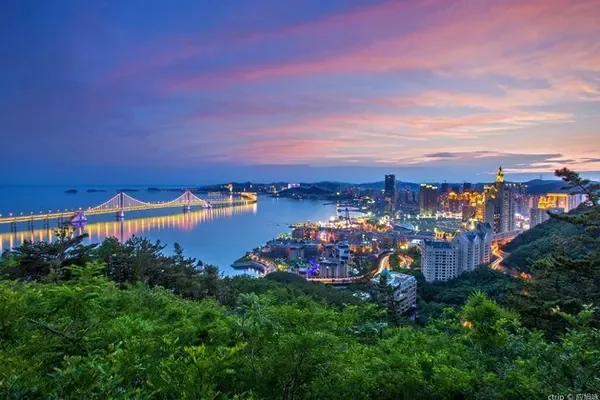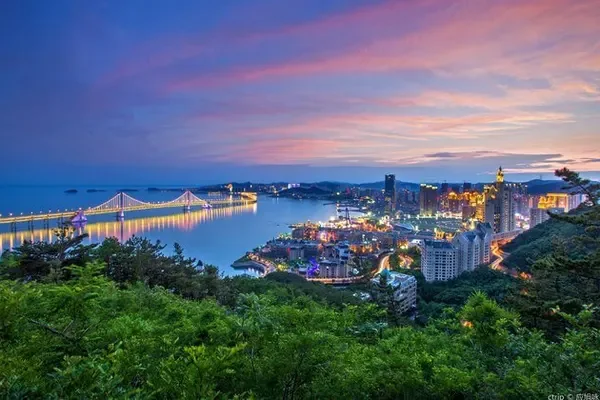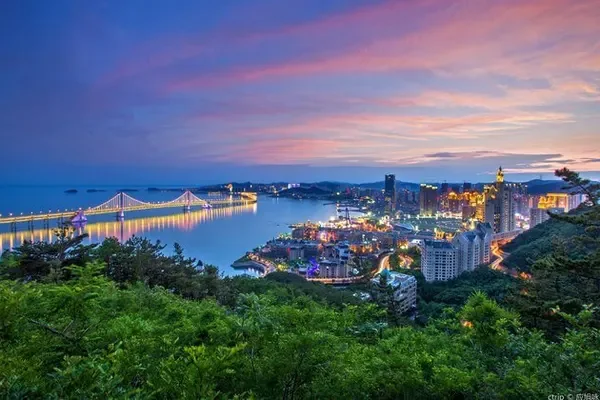Pofengling Red Leaf Sightseeing Scenic Spot is located in Youlan Valley, Huangshandian Village, Zhoukoudian Town, Fangshan District, where the Beijing ape-man site known as the Dragon Township is located. As early as 1929, Chinese paleontologist Pei Wenzhong discovered primitive human teeth, bones and a complete skull here, proving that there were human activities in the Beijing area 500,000 years ago. Huangshandian Village has numerous gold and silver monuments as well as word-of-mouth from the masses. In 2017, it was listed as the most beautiful leisure village in China "Characteristic Folk Village", in 2018 it was listed as a National Ecological Cultural Village, and in 2019 it was included in the list of the first batch of national rural tourism key villages. The beautiful Pofengling is also praised by the "China National Geographic" magazine as the most spectacular mountainous red leaf landscape in North China. Here grows the largest wild sumac in North China. In the next 22 days, Pofengling will be tightly surrounded by 200,000 tall and luxuriant wild sumac red leaves, like a lush and majestic autumn oil painting.


Stepping on the elegant winding path, step into the red leaf forest. Looking up, Pofengling is already colorful and full of forests. The sumac trees seem to have drunk the mellow wine, and the reds have their own advantages: some are pink, some are purple, some are bright red, some are scarlet, some are crimson, some are bright red, and so on, showing bright smiling faces one after another. This place used to be a backcountry that no one knew about, a trail that few people set foot in, and a poor mountain valley that no one cared about, but now it is full of red leaves all over the hillside, like layers of red waves reaching to the sky. How many years ago, Pofengling was still a wilderness "far away in the mountains and unknown to people". People from Zhoukoudian who have foresight and vision for development not only understand the poetry of red leaves, but also understand the economic value of red leaves. Therefore, they carried forward the spirit of the foolish old man, dug the mountain for many years, and used ornamental trees such as sumac and red maple to beautify this little-known barren mountain year by year. Today, Pofengling, which has been covered with colorful makeup, attracts many tourists from Beijing, Tianjin and Hebei every golden autumn.


There are many red-leaf tree species, and 80% of the red-leaf tree species in Beijing are sumac. If Xiangshan in late autumn is "thousands of mountains are red, and forests are dyed", then Pofengling is "red leaves and green middle reaches, colorful practice dancing in the sky", red, yellow, green, pink, black, and the blue sky and white clouds. Looking at it, it looks like strips of color dancing in the air, becoming a flowing ocean of colors. The bright colors come from the rich plant resources here. The total area of the Red Leaf Sightseeing Area in Pofengling is about 2,000 mu, and the circular trail up and down the mountain is more than 6,000 meters long. Persimmon trees, walnuts, peach trees, wild apricots, and poplars are mostly distributed at the slope, accompanied by wild jujube, wild pear, and wild chrysanthemum. Climbing up the steps on the Banpo, the two sides of the winding path are dominated by naturally tall cotinus cotinus, accompanied by elm, asparagus, jujube, and vitex. On the high slope, tall sumac, eucalyptus, and poplar are densely distributed, so dense that the sun cannot be seen.


Green leaves turn red because of both internal and external factors. There are two main substances that make the leaves appear red: one is carotene, which is an orange-red pigment commonly found in chloroplasts, and the other is anthocyanin, which exists in the cell fluid in the vacuole. When the cell fluid is alkali When the cell fluid is acidic, the anthocyanins are blue-purple, and when the cell fluid is acidic, the anthocyanins are red. After autumn, the anthocyanins in the leaves of cotinus cotinus increase, and the drop of temperature destroys and disappears the chlorophyll, so the green leaves become red leaves. The external factor of discoloration is the climatic conditions: when the temperature drops rapidly to a certain extent, and the temperature at night is much lower than that during the day, the leaves have not fallen, and most of the chlorophyll has been destroyed. The formation of chlorophyll, so the leaves quickly turn red. If the temperature drops slowly, and the temperature difference between day and night is not large, the chlorophyll has not been destroyed and the tree has withered, it will not become beautiful red leaves. This is the main reason why Cotinus cotinus in Beijing often does not turn red, but Cotinus cotinus in Pofengling becomes bright red.


Wild sumac is a resource-type plant with high utilization value. Its wood is yellow and can be used to extract yellow industrial dyes. The bark and leaves can also extract tannin. The wood is also a raw material for making furniture or carvings; The content of cyanine is gradually attracting people's attention, and it is expected to be developed as a new natural food coloring. Li Shizhen mentioned in "Compendium of Materia Medica" that "the wood is dyed yellow and red, which is called Zhehuang, which is taken by the emperor". Interestingly, on October 22 this year, the new emperor of Japan, Emperor Naruhito, wore a royal robe dyed with sumac during the enthronement ceremony of the main hall, which is the ocher yellow used for emperors after the Sui and Tang Dynasties. In the 11th year of Hongren in the early Heian period (the 15th year of Tang Yuanhe, 820), Emperor Saga took the Tang production brought back by the envoy Sugawara Kiyomizu as a model, and issued an imperial edict to modify the emperor's clothing, and formulated the "Huangxiu dyeing" used by the emperor's various associations. clothing" ("Japanese Chronicle"). The color of its clothes is ocher yellow dyed by sumac and sumac, which has become an absolutely forbidden color except for the emperor in Japan. When Emperor Akihito ascended the throne in 1989, the belted attire he used was the most solemn "Sangha dyed imperial robe".


Cotinus cotinus grows fearlessly on mountains with poor soil, loose rocks, and little water. The natural conditions are very harsh, and it grows together with those little-known shrubs, vines, and weeds. Naturally, in such a harsh environment, cotinus cotinus can only appear as a shrub. Even if it has grown for thousands of years, it is still not thick enough. Its body is stubborn and proud. This is not a tree, but the holy spirit of life, a realistic representation of vicissitudes, and suffering witness. Standing on the top of the mountain, overlooking the Youlan Valley, you can only see the peaks facing each other above the canyon, the edge of the plank road, the red leaves covering the eyes, and the distant mountains, like a prairie fire. , Passionate, no words to praise! In order to allow tourists to enjoy the most beautiful red leaves, Pofengling Scenic Area has specially set up photo check-in frames in different locations, so that tourists can take their own autumn blockbusters at their fingertips. On the way to check in, there are many corner pavilions, stone tables and benches that blend into the red leaves, which can be used for tourists to rest and enjoy the beautiful scenery from a different angle. Walking to the 3,000-meter-high Yingzui Rock in Pofengling, you can see colorful colors as far as you can see. At sunset, the afterglow passes through the mountain pass of Coffin Mountain (meaning "seeing the coffin to make a fortune"), and forms an interesting contrast with the red leaf forest.


Beijing, a bustling international city. There are many high-rise buildings surrounding the ancient Forbidden City. Although the villagers living in Huangshandian are only a few tens of kilometers away from the urban area, they seem to be as far away from the urban area as a paradise. After years of exploration, planning and design, Huangshandian Village has continuously explored new ideas for the development of the homestay industry through the village-enterprise cooperation model, and has created a number of rural homestay brands that are deeply integrated with the natural landscape. The Yunshang Stone House has 10 courtyards, with a total construction area of 1,500 square meters. The overall building of the house adopts the local architectural style, which harmoniously combines the characteristics of the farmhouse with the modern lifestyle. In terms of the main materials of the house, all the local stone materials in Huangshandian Village are collected in the courtyard of Taoyegu B&B. In terms of interior design, it fully integrates the regional culture and natural features of Huangshandian. The grandma’s house basically retains the original farmhouse architecture, as well as the appearance texture and spatial relationship enclosed by the courtyard, so that it can smoothly integrate into the village context and preserve the rural memory. From the first step into grandma's small courtyard, all the irritability suddenly disappeared without a trace, the faint fragrance of the mountains and fields passed through the tip of my nose, and the peace and happiness that was once thousands of miles away returned to my heart.


In order to reflect China's traditional culture and memory, and show the characteristics of Fangshan's intangible cultural heritage, the Red Leaf Festival also set up an intangible cultural heritage market, and specially selected several intangible cultural heritage art inheritors from Fangshan and surrounding areas to come here. Ancient handmade incense, windmill making, as well as dough sculpture skills and chicken roasting skills, tourists can experience the cultural characteristics of intangible cultural heritage at close range. There is also a large collection of mountain goods that are necessary for the annual Red Leaf Festival. The rose cakes, rose ice cream, hawthorn juice, chrysanthemum wine and other items sold on site are all made of locally grown fruits and flowers. The Red Leaf Festival also has a farming experience area, where corn fields are neatly lined up, where you can remove corn and grind cornmeal by yourself, feeling the atmosphere of the countryside. A special reminder is that this Red Leaf Festival will last until November 15th, after which the scenic spot will be closed and will continue to operate in early April next year.



